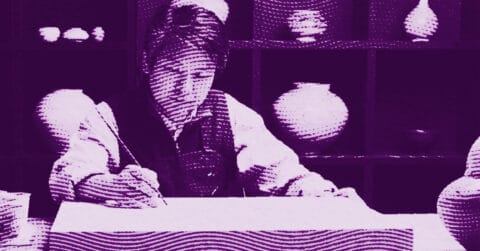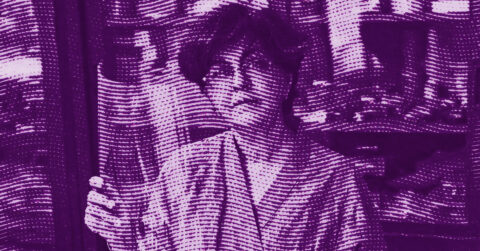Listen to me carefully, you bunch of snobs! If you haven’t heard of Kao Yu yet, it’s because you live in a bubble as hermetic as that of collectors who only buy recognized signatures. This native of Guizhou, born in 1981, is one of the most singular representatives of the generation of artists born in the 80s, this famous generation that grew up in a China in full economic metamorphosis.
It is no coincidence that Kao Yu’s works broke the auction ceiling in 2008 with “Killing the Tiger” sold for over a million yuan, a record for an artist of his generation. His visual language borrows as much from the codes of animation as from those of classical fine arts, thus creating a delicious friction between tradition and modernity. But do not be fooled: behind the apparent lightness of his colored canvases hides a sharp critique of contemporary Chinese society.
In the contemporary Chinese artistic landscape, Kao Yu stands out for his ironic approach. One of the most beautiful examples is his series “Milky Way Hero”, where he revisits the spatial dreams of the Maoist era. “The scene reflects the dominant vision of the country for the future during the Mao era”, he explains. “It has infiltrated our visual history via the pop art of the time, then progressed towards revolutionary propaganda posters.” Kao Yu confronts us here with what Roland Hartman called “mythological idealization”, this tendency to transform collective aspirations into quasi-religious narratives.
His relationship with the panda, his subject of predilection for years, is profoundly ambivalent. Contrary to what one might believe, Kao Yu detests this national symbol: “The ‘charming’ but lazy panda, in my opinion, is better suited to being a teddy bear, not a symbol of national pride.” By transforming this docile animal into a violent and unstable creature, Kao Yu brilliantly deconstructs an emblematic symbol of China. In doing so, he reminds us of what Jacques Ranciere identified as the political function of art: “reconfiguring the distribution of the sensible”.
During his exhibition “For the failed, let’s raise our glasses” in 2010, Kao Yu borrowed the composition of Manet’s “Luncheon on the Grass” to create a scene where his anthropomorphic pandas picnic in a relaxed atmosphere. This is not trivial: Manet himself was rejected from the official Salon, much like many young contemporary artists feel excluded from the dominant art system. This pictorial reference functions as a meta-commentary on the position of marginal artists in art history.
His later creations, such as the series “Zhong Kui Takes Office” (2012), draw from traditional Chinese mythology. Zhong Kui, this legendary demon hunter, becomes under his brush a metaphor for the artist confronted with the demons of the art market. This approach evokes what Claude Levi-Strauss calls “mythical bricolage”, where ancient cultural elements are rearranged to express contemporary concerns.
In 2013, Kao Yu made a surprising decision: to leave Beijing, the epicenter of the Chinese art world, to return to Chongqing. This radical gesture was not just a simple geographical change, but a true artistic statement. As he explains: “In Beijing, I had to control 100 details in my paintings, now I only control 10.” This deliberate simplification reflects his quest for authenticity, far from the pressures of the market.
In Chongqing, Kao Yu opened a bar, “Drunken Master”, which has become a meeting point for intellectuals and artists. This professional diversification allowed him to regain control of his artistic production: “Money to business, art to art.” This attitude strangely echoes the position of Friedrich Schiller on aesthetic autonomy, according to which art can only be truly free when it is liberated from material necessities.
His exhibition “Ideal 2” in Chongqing in 2017 marked a turning point in his career. Definitively abandoning the panda, he turned towards a deeper exploration of his personal experience of post-reform China. In “Aspirations”, a young pioneer with a red scarf contemplates a blue sky, an image that perfectly captures the innocence and hopes of children growing up in that era. This work immerses us in what Svetlana Boym so aptly named “reflective nostalgia”, which examines the past critically rather than glorifying it blindly.
Kao Yu’s painting technique is as noteworthy as his themes. His vibrant color blocks, sharp outlines, and bold use of perspective recall both traditional Chinese prints and American comics. This visual hybridity perfectly reflects the cultural complexity of contemporary China, torn between its millennial roots and its frenzied desire for modernity. Art theorist Rosalind Krauss would undoubtedly have qualified his work as an “expanded field”, where the boundaries between traditional media are constantly questioned.
When looking at the recent evolution of Kao Yu’s work, notably in his exhibition “Complaints, Compliments and Flatulences” (2024), one is struck by his ability to reinvent himself while remaining faithful to his fundamental concerns. In “The Artist Who Farts”, he represents Le Petomane, this famous French artist of the Belle Epoque who entertained crowds with his controlled flatulence. This irreverent reference functions as a metaphor for contemporary art itself: sometimes noisy, often provocative, but always profoundly human in its vulnerability.
In “Farmer Wanting to Kill a Rooster”, inspired by George Orwell’s “Animal Farm”, Kao Yu transposes the political allegory into a Chinese context, creating what curator Wang Jiang calls “a sophisticated comedy whose most punchlines come from the performer’s self-derision.” These recent works show an artist who, in the words of critic Pierre Bourdieu, “plays with the rules of the game” rather than simply following or rejecting them.
What truly distinguishes Kao Yu is his ability to navigate between different worlds: that of elite contemporary art and that of popular culture, that of Chinese tradition and that of globalization, that of social critique and that of commercial success. This balancing act is precisely what makes his work so relevant today.
Kao Yu’s experience reminds us that the most significant art often emerges from the tensions and contradictions of its time. His decision to distance himself from the center to see the whole, to slow down to better reflect, offers a precious lesson in our world obsessed with speed and constant visibility.
Do not be fooled: behind Kao Yu’s apparent nonchalance hides a lucid and ruthless observer of contemporary Chinese society. As he himself says: “I observe the world with drunken eyes.” This drunkenness is not that of unconsciousness, but that of freedom, the freedom to see beyond appearances, to say the unspeakable, to paint the invisible.
Kao Yu shows us that true art does not reside in adhering to the trends of the moment or in reproducing proven formulas, but in the ability to visually translate the tensions and contradictions of our time. His trajectory, from promising young artist to philosophical bar owner, embodies a form of subtle resistance against the homogenizing forces of the global art market.
It is high time that we recognize in Kao Yu not simply a talented representative of his generation, but an artist who, through his singular journey and refusal of easy compromises, redefines what it means to be a contemporary Chinese artist in a globalized world. His paintings are not just aesthetic objects, but invitations to rethink our relationship to the world, to history, and to ourselves.
- Hartman, Roland. “Contemporary Mythologies in Asian Art”, Journal of Comparative Aesthetics, 2011.
- Ranciere, Jacques. “The Distribution of the Sensible: Aesthetics and Politics”, La Fabrique, 2000.
- Levi-Strauss, Claude. “The Savage Mind”, Plon, 1962.
- Schiller, Friedrich. “Letters on the Aesthetic Education of Man”, 1795.
- Boym, Svetlana. “The Future of Nostalgia”, Basic Books, 2001.
- Krauss, Rosalind. “Sculpture in the Expanded Field”, October, Vol. 8, 1979.
- Bourdieu, Pierre. “The Rules of Art”, Seuil, 1992.
















